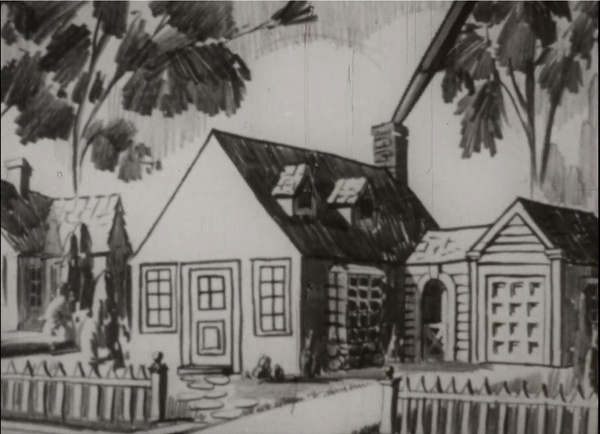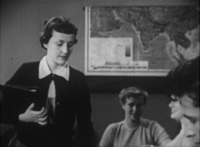Portrayals of Society

Even the animated house at 0 minutes and 46 seconds in Johnny Learns his Manners is a middle-class suburban house complete with a white picket fence.
Production houses, being private businesses, marketed films to the largest audience possible. The byproduct of mass appeal was uniformity of settings, with most being centered in an idealized suburban, middle-class environment.1-2 An example of this is the freshly sketched single-family home shown below from the beginning of Johnny Learns his Manners, complete with the white picket fence. The issues covered within films were also adjusted to fit the target audience. Portrayals of problematic behaviors or challenging social situations often involved suburban locales (e.g., biking dates and weenie roasts in What to do on a Dates) and middle-class conventions (e.g., the use and ownership of cars by teenagers in Gossip).
Additionally, social guidance films presented their vision of American teen society without people of color. The mostly white, middle-class film makers reflected the segregated realities of schools at the time in their creations.1 Monetary success can likely attribute to some of the reason for the exclusion of people of color, as majority white schools had the deepest pockets and would mostly refuse to buy films with diverse character representation.1 This likely being for the fear of greater racial mixing by white society at the time. Ted Peshack, the house director for Coronet Films in the 1940s and 1950s even detailed the practice of segregated filming of social guidance films in an interview with researcher Ken Smith on August 16, 2000:
Well, it so happened that the state of Georgia and I think officially the state as well as the whole rest of that area, were very big on buying Coronet films. And so we got the word down, hey don’t offend Georgia in any way. And that certainly affected the way we treated minorities and so there was no integration shown. In fact, on more than one occasion we had some integration problem but we managed to get the camera angle so it didn’t show ... other than that we didn’t have any problem on that. But you know back then we had to be practical, just like the successful people still do.1
The practice of segregated filming in social guidance films, even in the varied background settings of larger shots, are exemplified below.

The background characters in More Dates for Kate, exemplified by this still at 4 minutes and 38 seconds, reflected the segregated life in the United States at the time.

One could not find a single minority individual visible in What to do on a Date, even in this populated scene at a swimming pool at 6 minutes and 46 seconds.


